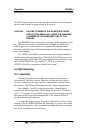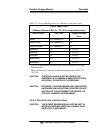
Operation MX300-I
Teledyne Analytical Instruments 28
2.3.4 Discrepancy in Readings
The MX300-I instrument should be used to measure the oxygen
concentration exiting another oxygen mixing device or life support
system (i.e., a blender, incubator or anesthesia machine). The
information obtained from the MX300-I should never be used to adjust a
life-support system, but should only be used as an indication that the life
support system or device may require service and/or calibration.
When a discrepancy in oxygen readings is detected, the oxygen
analyzers readings should be verified by checking the MX300-I battery
condition and calibration using 100% Oxygen. If the monitor can be
calibrated, the unit can be assumed to be in good working order and
capable of providing readings to specification. If, after reinstalling the
unit, the discrepancy in oxygen readings persists, the problem is most
likely elsewhere (i.e., flow blockage, primary device error, etc.). Further
investigation should be made until the discrepancy in readings is
resolved. The troubleshooting section of this manual may provide
additional assistance in locating the problem.
Note: The MSDS on this material is available upon request
through the Teledyne Environmental, Health and Safety
Coordinator. Contact at (626) 934-1592
2.3.5 Anesthetic Gases
2.3.5.1 GASES THAT INDUCE READING ERROR
When using the R17MED sensor in the presence of anesthetic gases
such as Halothane, the oxygen reading may fall (see Table below). The
magnitude of this error will depend upon the level of oxygen and the
duration of exposure.
The anesthetic agents listed in the following table (Halothane,
Enflurane, Isoflurane, Sevoflurane, and Desflurane) were vaporized into
a stream of 30% oxygen / 70% nitrous oxide, and the resulting drops in
oxygen level after an exposure of approximately two hours were noted.
Exposures in excess of two hours may produce slightly greater
errors. The errors listed are typical for all oxygen sensors such as the
R17MED. Exposing the sensor to air or gases that do not contain
anesthetic agents for a period of time equal to or greater than the exposure
interval will eliminate the reading error in most cases.


















